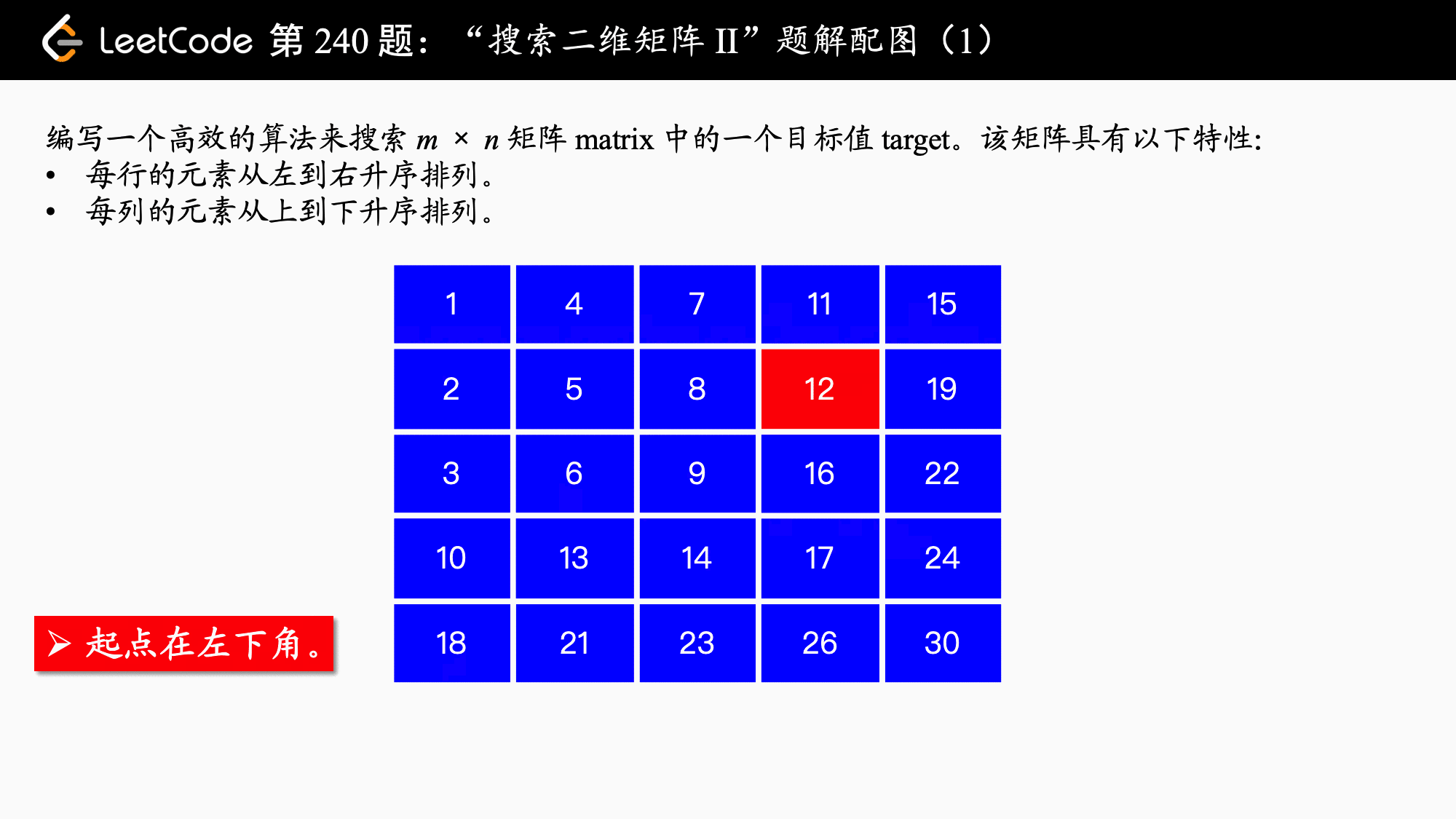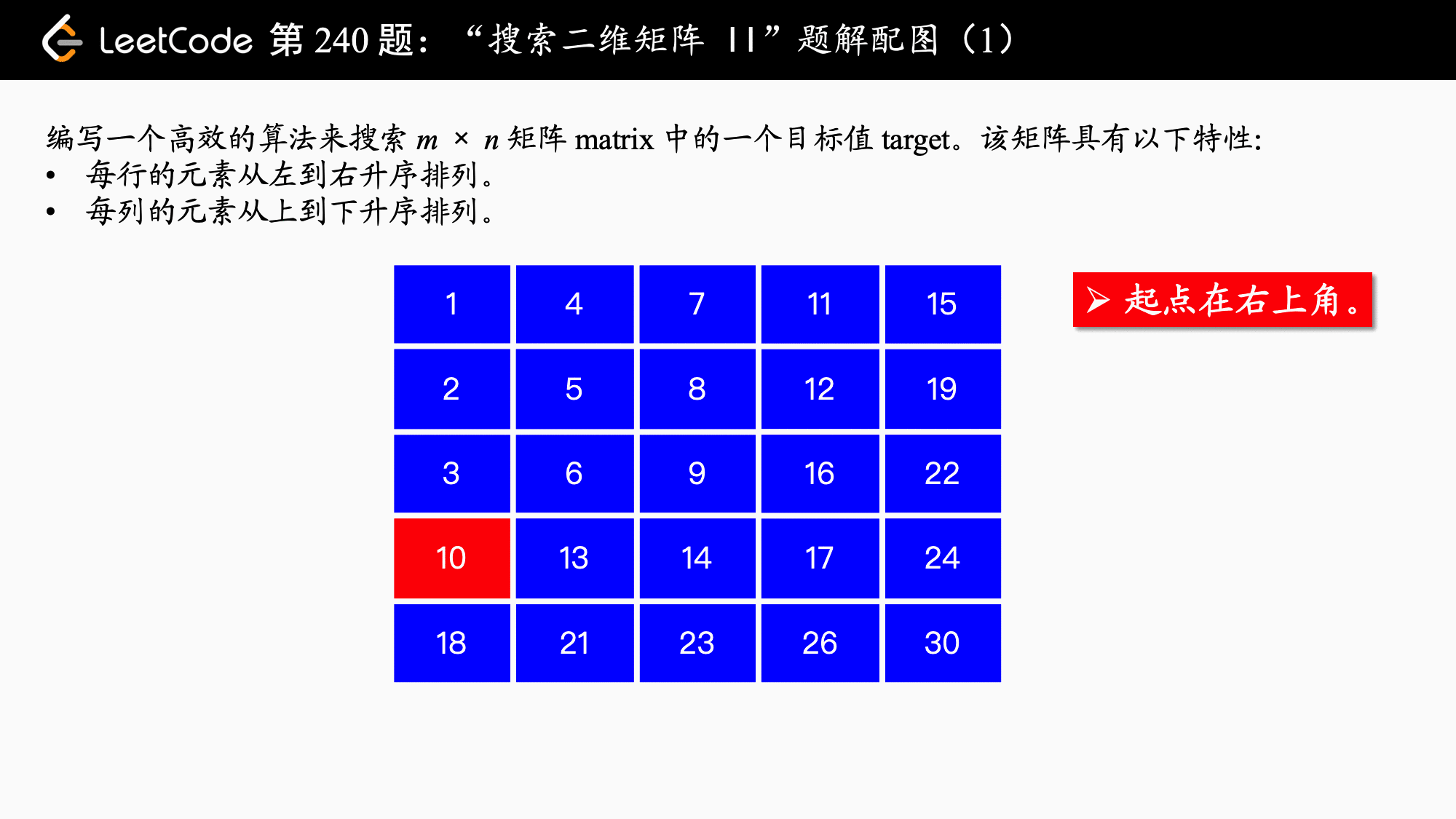240. 搜索二维矩阵 II
题目描述
编写一个高效的算法来搜索 m x n 矩阵 matrix 中的一个目标值 target。该矩阵具有以下特性:
每行的元素从左到右升序排列。
每列的元素从上到下升序排列。
示例:
现有矩阵 matrix 如下:
[
[1, 4, 7, 11, 15],
[2, 5, 8, 12, 19],
[3, 6, 9, 16, 22],
[10, 13, 14, 17, 24],
[18, 21, 23, 26, 30]
]
给定 target = 5,返回 true。
给定 target = 20,返回 false。
解答
思路一
思路也就是每次遍历首行和首列,如果矩阵为空或者矩阵首个元素大于target就返回False,如果在首行或者首列中找到了,就返回True。
当然,边界条件比较多,我是提交了几次,然后处理的边界。代码如下:
class Solution:
def searchMatrix(self, matrix, target):
"""
:type matrix: List[List[int]]
:type target: int
:rtype: bool
"""
# 暴力法
# 预防[[]]这种情况
if len(matrix) == 0:
return False
# [[],[1,2,3]] 预防这种情况的矩阵
if len(matrix[0]) == 0:
subMatrix = []
for i in range(1, len(matrix)): # 不包括首行
temp = matrix[i][1:]
if len(temp) > 0:
subMatrix.append(temp)
return self.searchMatrix(subMatrix, target)
# 找顶部的一行和最左边的一列
for i in matrix[0]:
if i == target:
return True
for i in range(len(matrix)):
print(matrix[i][0], target)
if matrix[i][0] == target:
return True
# 截取矩阵,也就是去掉第一行、第一列后的矩阵
subMatrix = []
for i in range(1, len(matrix)): # 不包括首行
temp = matrix[i][1:]
if len(temp) > 0:
subMatrix.append(temp)
# 边界条件 ①矩阵为空,没找到,就返回False
if len(subMatrix) == 0:
return False
# 边界条件 ②矩阵的第一个元素大于target,必然返回False
elif subMatrix[0][0] > target:
return False
return self.searchMatrix(subMatrix, target)结果:
思路二
当然还有更加暴力的解法,因为是矩阵,不妨一个元素一个元素的取出来,然后判断。
class Solution:
def searchMatrix(self, matrix, target):
"""
:type matrix: List[List[int]]
:type target: int
:rtype: bool
"""
for row in matrix: # row
for ele in row:
if ele == target:
return True
return False我们看结果:
两种方法对比

虽然前一种暴力法,使用了数据本身有序的特点,做了边界处理,避免了额外的计算。
但是,由于使用的是递归的访问方式,也就导致了对内存消耗的加剧。
这里也不难记起,以前数据结构中学过的:“递归调用,最好用栈来改进。能用循环解决的就不要用递归。”
思路三
由于这个题目所处的位置是“分治法”,故而也企图找到一种思路用分治来解决。
这里我画了一个简略的图来解释这个过程:
但是实现比较复杂,这里就不写代码实现了。
思路四
在leetcode网站的解答区,看见了这么一个思路,如下图:

相信,看图也就明白了这个思路的巧妙之处!
代码实现也比较简单:
class Solution:
def searchMatrix(self, matrix, target):
"""
:type matrix: List[List[int]]
:type target: int
:rtype: bool
"""
# 以左下角开始
if len(matrix) == 0:
return False
row = len(matrix)
col = len(matrix[0])
finded = False
i, j = row - 1, 0
while not finded and (i >= 0 and j < col):
if matrix[i][j] == target:
return True
elif matrix[i][j] > target:
i = i - 1
elif matrix[i][j] < target:
j = j + 1
return False结果:
来源:力扣(LeetCode)
链接:https://leetcode-cn.com/problems/search-a-2d-matrix-ii




